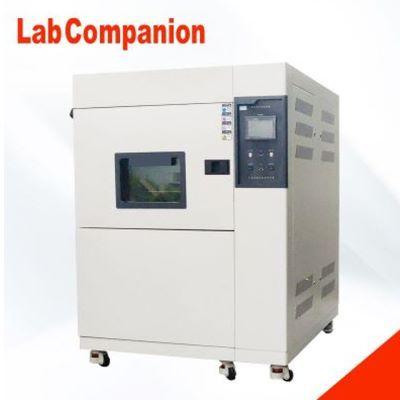Envíanos un correo electrónico :
info@labcompanion.cn-

-

Solicitar una llamada :
+86 18688888286
Detección de estrés cíclico de temperatura (2)
Introducción de parámetros de tensión para la detección de tensión cíclica de temperatura:
Los parámetros de tensión de la detección de tensión cíclica de temperatura incluyen principalmente lo siguiente: rango extremo de temperatura alta y baja, tiempo de permanencia, variabilidad de temperatura, número de ciclo
Rango extremo de temperatura alta y baja: cuanto mayor sea el rango de temperatura extrema alta y baja, menos ciclos se requieren, menor será el costo, pero no puede exceder el producto que puede soportar el límite, no causa un nuevo principio de falla, la diferencia entre el Los límites superior e inferior de cambio de temperatura no son inferiores a 88°C, el rango típico de cambio es de -54°C a 55°C.
Tiempo de permanencia: Además, el tiempo de permanencia no puede ser demasiado corto, de lo contrario será demasiado tarde para que el producto bajo prueba produzca cambios de tensión de expansión y contracción térmica, en cuanto al tiempo de permanencia, el tiempo de permanencia de diferentes productos es diferente, usted Puede consultar los requisitos de especificación relevantes.
Número de ciclos: En cuanto al número de ciclos de detección de tensión cíclica de temperatura, también se determina considerando las características del producto, la complejidad, los límites superior e inferior de temperatura y la tasa de detección, y el número de detección no debe excederse, de lo contrario causará daño innecesario al producto y no puede mejorar la tasa de detección. El número de ciclos de temperatura varía de 1 a 10 ciclos [cribado ordinario, cribado primario] a 20 a 60 ciclos [cribado de precisión, cribado secundario], para la eliminación de los defectos de mano de obra más probables, se pueden eliminar eficazmente entre 6 y 10 ciclos. , además de la efectividad del ciclo de temperatura, depende principalmente de la variación de temperatura de la superficie del producto, más que de la variación de temperatura dentro de la caja de prueba.
Hay siete parámetros principales que influyen en el ciclo de temperatura:
(1) Rango de temperatura
(2) Número de ciclos
(3) Tasa de temperatura de Chang
(4) Tiempo de permanencia
(5) Velocidades del flujo de aire
(6) Uniformidad del estrés
(7) Prueba de funcionamiento o no (Condición de funcionamiento del producto)
Clasificación de fatiga por detección de estrés:
La clasificación general de la investigación sobre la fatiga se puede dividir en fatiga de ciclo alto, fatiga de ciclo bajo y crecimiento de grietas por fatiga. En el aspecto de Fatiga de bajo ciclo, se puede subdividir en Fatiga Térmica y Fatiga Isotérmica.
Acrónimos de detección de estrés:
ESS: Detección de estrés ambiental
FBT: Probador de placa de función
ICA: analizador de circuitos
TIC: probador de circuitos
LBS: probador de cortocircuito de placa de carga
MTBF: tiempo medio entre fallos
Tiempo de los ciclos de temperatura:
a.MIL-STD-2164(GJB 1302-90): En la prueba de eliminación de defectos, el número de ciclos de temperatura es 10, 12 veces, y en la detección sin problemas es 10 ~ 20 veces o 12 ~ 24 veces. Para eliminar los defectos de mano de obra más probables, se necesitan entre 6 y 10 ciclos para eliminarlos de manera efectiva. 1 ~ 10 ciclos [cribado general, cribado primario], 20 ~ 60 ciclos [cribado de precisión, cribado secundario].
B.od-hdbk-344 (GJB/DZ34) El equipo de detección inicial y el nivel de unidad utilizan de 10 a 20 bucles (normalmente ≧ 10), el nivel de componente utiliza de 20 a 40 bucles (normalmente ≧ 25).
Variabilidad de temperatura:
a.MIL-STD-2164(GJB1032) establece claramente: [Tasa de cambio de temperatura del ciclo de temperatura 5 ℃/min]
B.od-hdbk-344 (GJB/DZ34) Nivel de componente 15 °C /min, sistema 5 °C /min
do. La detección de tensión cíclica de temperatura generalmente no se especifica como variabilidad de temperatura, y su tasa de variación de grados comúnmente utilizada suele ser de 5 °C/min.
